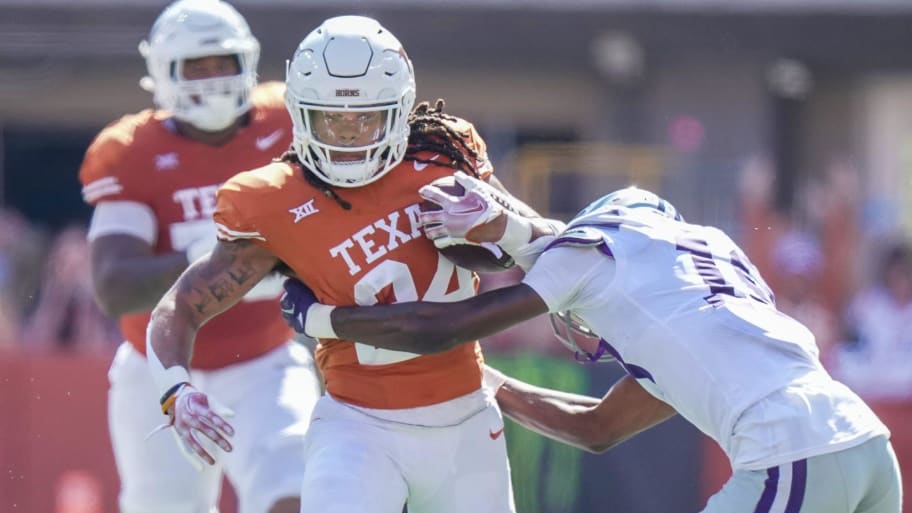
Rookies, across all positions, have seen their value rise in the world of fantasy football. Fantasy managers, including myself, get excited about the thought of “new blood” and their potential in the stat sheets. We talk about their talent and opportunity, which can combine to make a first-year player quite attractive in our fantasy leagues.
However, sometimes we overlook a player’s potential “fit” with his new team. For example, if a running back played in a zone scheme in college and lands with an NFL team that runs more gap scheme plays, the learning curve could be somewhat greater. It’s like a mechanic who works on German cars, but suddenly moves to a shop that deals with American vehicles.
There are going to be at least some differences, so it might be a bit tougher to grasp new concepts immediately. With that in mind, I researched 10 prominent rookie running backs and looked at the scheme(s) they ran in college, compared to what their new NFL team will run. This data could be useful in knowing who might make an instant impact based on the combination of skill, potential volume and fit, and who might need some “seasoning.”
I’ve also included, because no runner is going to be a three-down running back at the next if he can’t pass protect at a high level.
Jonathon Brooks, Carolina Panthers
Zone carries: 101
Gap carries: 86
Brooks was used in zone 54% of the time in his final collegiate season, so he has experience in both zone and gap schemes. New Panthers coach Dave Canales’ lead back in Tampa Bay last season, Rachaad White, was used in a zone scheme 55% of the time. As a result, Brooks seems like a nice fit.
Pass Blocking Grade: 77.0 (RB62)
Trey Benson, Arizona Cardinals
Zone carries: 59
Gap carries: 79
Benson, like Brooks, was used in both zone and gap schemes last season. However, he ran gap slightly more often (57%). That’s almost a mirror image of the percentage of gap the Cardinals ran last season with James Conner (55%). So, Benson looks like a well-fitting heir apparent in this offensive attack.
Pass Blocking Grade: 84.6 (T-RB8)
MarShawn Lloyd, Green Bay Packers
Zone carries: 48
Gap carries: 66
Lloyd ran gap 57% of the time during his final collegiate season, so he’s obviously familiar with both schemes. The Packers two top runners last season, Aaron Jones and AJ Dillon, combined to run zone 58% of the time. Still, the rookie has enough awareness to make a smooth transition at the next level. He needs to improve his ball security, which was a real problem in college, so monitor that.
Pass Blocking Grade: 28.9 (N/A)
Kimani Vidal, Los Angeles Chargers
Zone carries: 157
Gap carries: 94
Vidal ran zone 62% of the time in his final season at Troy. Now, let’s look at the 2022 Baltimore Ravens, whose offense was run by new Chargers offensive coordinator Greg Roman. He had three backs with 80-plus carries that year, Kenyan Drake, J.K. Dobbins and Gus Edwards. That trio combined to run gap plays at a 72% clip, compared to just 28% for zone plays. Also keep in mind that Dobbins and Edwards are now with the Chargers, and they’ll have a scheme fit advantage over the rookie. I still like Vidal as a sleeper late in fantasy drafts, but it might be a slow statistical burn in 2024.
Pass Blocking Grade: 76.7 (T-RB70)

Blake Corum, Los Angeles Rams
Zone carries: 79
Gap carries: 123
Corum, who ran gap around 60% of his carries at Michigan last season, will be a popular handcuff in most drafts behind incumbent starter Kyren Williams. The rookie is a nice fit for coach Sean McVay’s ground attack, as Williams ran gap around 62% of the time last season. In all, Rams runners ran gap at a 71% clip.
Pass Blocking Grade: 50.3 (N/A)
Jaylen Wright, Miami Dolphins
Zone carries: 50
Gap carries: 86
Wright ran both schemes in his final season at Tennessee, but he was utilized more often in gap (63%). Coincidentally, the Dolphins top two backs from last season, Raheem Mostert and De’Vone Achane, ran zone schemes 63% of the time. Wright will need one of those two runners to miss time in order to get any sort of volume or have fantasy appeal, and he’ll also have a slight learning curve too.
Pass Blocking Grade: 72.6 (T-RB140)
Bucky Irving, Tampa Bay Buccaneers
Zone carries: 62
Gap carries: 96
The Buccaneers hired former Kentucky offensive coordinator Liam Coen to take over the same role at the next level. His 2023 offense with the Wildcats ran gap 61% of the time. His lead back, Ray Davis, ran it on 64% of his carries. So, while Irving won’t usurp Rachaad White atop the team’s depth chart, he could have an easier pro transition and looks likely to be a handcuff in fantasy drafts.
Pass Blocking Grade: 21.1 (N/A)
Ray Davis, Buffalo Bills
Zone carries: 64
Gap carries: 118
Speaking of Davis, he should fit into the Bills offense well based on the usage from his final collegiate season. Again, he ran gap 64% of the time. In five games with Joe Brady leading the Buffalo offense in 2023, the team’s runners ran gap 63% of the time. Should James Cook go down, Davis should be able to fill right in.
Pass Blocking Grade: 34.5 (N/A)
Audric Estime, Denver Broncos
Zone carries: 88
Gap carries: 121
Estime ran gap 58% of the time in his final year at Notre Dame. By comparison, Javonte Williams and Samaje Perine combined to run gap and zone at nearly the same rate (50%) for the Broncos last season. Jaleel McLaughlin, on the other hand, was more of a zone runner (71%). Estime, a bigger back at 5’11” and 227 pounds, is closer in comparison to Williams and could earn a handcuff role in Year 1.
Pass Blocking Grade: 63.6 (N/A)
Tyrone Tracy Jr., New York Giants
Zone carries: 65
Gap carries: 47
Tracy Jr. had a slight lean to the zone scheme (57%) in his final year at Purdue. That will help him transition well to the next level, as the Giants ran zone 60% of the time last season. That includes former starter Saquon Barkley, who ran zone 148 times on his 247 carries. Tracy Jr. could be the top handcuff for veteran starter Devin Singletary, so look for the rookie to be worth a late round look in redrafts.
This article was originally published on www.si.com as Fantasy Football Rookies: Getting to Know the Running Backs .







